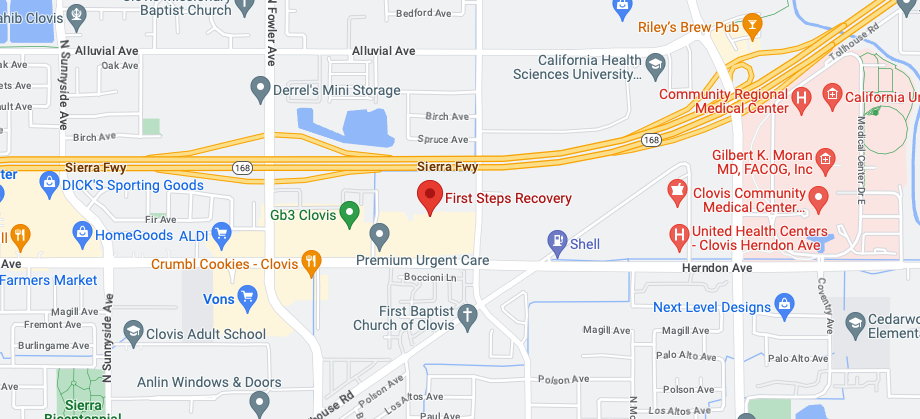Human bodies are designed to maintain homeostasis. However, when people have experienced trauma, homeostasis can cause them to maintain the bodily state that resulted from the trauma. In other words, the body can remain “frozen” in time. This prevents clients from fully coping with the emotions and thoughts associated with the trauma. Traumatic experiences disrupt one’s natural homeostasis and upset one’s stable equilibrium. Fortunately, it is possible to break through unhealthy homeostasis with the right tools and guidance.
At First Steps Recovery, a trauma-informed approach to treatment is used with every person. Clients are provided with personalized treatment plans that are best suited to their unique needs. Breaking through unhealthy homeostasis is done in a calm, welcoming, and nonjudgmental environment. No one is expected to heal from their trauma in one session. First Steps Recovery understands that healing takes time and overcoming these “locked” or “frozen” moments happens gradually.
Unhealthy Homeostasis When Coping With Trauma
Homeostasis is the state in which the body maintains its equilibrium. As explained, those who have experienced trauma or undergone surgery often disrupt their homeostasis due to overwhelming feelings of stress or panic. Those who have experienced trauma often suffer from emotional and mental stress, which can affect their physical well-being over a period of time. The nervous system then adjusts to trauma and creates an unbalanced and unhealthy homeostasis. This causes these memories to become stuck, as mentioned before, and trauma remains in the body, mind, and emotions long-term.
However, it is unhealthy to leave trauma unaddressed. Clients may experience flashbacks due to certain stimuli that bring up these experiences once again. The body, therefore, is constantly fighting against itself as it tries to suppress or store this trauma over and over again. Not only does the physical and mental body become exhausted but the person never fully engages with their trauma to heal. Instead, it is only pushed aside.
Post-Traumatic Stress Disorder and Other Trauma Disorders
In some cases, when an individual experiences one or more instances of trauma, post-traumatic stress disorder (PTSD) and other trauma disorders occur. Traumatic experiences can be physical, emotional, or mental. PTSD, specifically, is characterized by continuing to have nervous-system symptoms related to an incident more than a month after it occurred. This can include anxiety, phobias, panic attacks, flashbacks, intrusive thoughts, avoidance of places or situations, and more.
Those with PTSD and trauma may experience sleep issues, eating habit changes, and other lifestyle alterations that interfere with daily life. Mood swings, emotional outbursts, irritability, and recklessness are other effects of trauma disorders that clients may experience.
The cause of these trauma responses is that a significant degree of stress affects the amygdala, hippocampus, and prefrontal cortex. Cortisol and norepinephrine levels increase to help one cope with stressors and future stressors. This is where the imbalance of homeostasis occurs. The brain adapts to these unhealthy levels. The mind and body respond to these shifts, putting the client in a constant state of defense. Rather than address the trauma because this may bring on more stress, the body and mind fight against it.
A Trauma-Informed Approach at First Steps Recovery
The six guiding principles of a trauma-informed approach include safety, trustworthiness and transparency, peer support, collaboration, empowerment, and cultural/historical/gender issues. An approach considering these factors is implemented into addiction and mental health recovery. This helps clients feel supported and comfortable during the healing process. As clients have many different kinds of life experiences that shape who they are, First Steps Recovery works treats their experiences with care.
This trauma-informed approach is useful when coping with unhealthy homeostasis due to trauma because clients are put into an environment where they feel like they can be vulnerable. Many clients coping with trauma often feel as if they cannot express themselves and their experiences out of fear of judgment. This does not have to be the case. Having a secure and safe environment for discussing these topics helps clients break through these barriers, heal from their trauma, and return to a healthy level of homeostasis.
Services at First Steps Recovery That Help Clients Overcome Unhealthy Homeostasis
To overcome unhealthy homeostasis due to coping with trauma and stress, First Steps Recovery offers multiple clinical and holistic services that promote comfort and healing. Cognitive-behavioral therapy (CBT) and dialectical behavior therapy (DBT) are two talk therapies offered.
DBT is a type of CBT that is directed at clients who experience very complex, difficult emotions on a more intense level. Many clients also use CBT in order to address their inner thoughts, thought patterns, emotions, and behavior patterns. Working with these patterns helps clients restructure their thoughts to produce healthier behaviors.
Another clinical service for coping with trauma is brainspotting. Brainspotting is an alternative therapy that accesses the area of the brain where trauma tends to become stuck. In this therapy, clients do not need to relive their experiences in order to heal from trauma. Rather, brainspotting targets this unhealthy homeostasis and addresses the relevant area of the brain to help clients process their emotions and thoughts more fully.
Here at First Steps Recovery, we use a trauma-informed approach to help clients heal in a way that is personal to them. For clients coping with trauma, specifically, the staff understands that it is difficult to open up about one’s experiences, and trauma often becomes stuck in the body. Trauma impacts the brain, especially areas that are associated with stress and emotional regulation. The brain responds to this trauma and increased levels of stress by “storing” or “freezing” those feelings. This hinders clients from being able to address their trauma and fully heal. Through trauma-informed practices, such as cognitive-behavioral therapy (CBT) and brainspotting, clients can surpass this unhealthy homeostasis. For more information, please call us at (844) 489-0836.
Dr. Curl is the Medical Director and primary on-site provider for First Steps Recovery. He is a Board Certified Internist and Addiction Medicine Specialist having attended the David Geffen School of Medicine at UCLA and completing his residency at Mount Auburn Hospital with Harvard Medical School. Following several years work as an internist and physiatrist (physical medicine and rehabilitation). Dr. Curl completed the Addiction Medicine Fellowship at Howard University in Washington DC and participated as a RAM Scholar (Research in Addiction Medicine). While part of the fellowship, Dr. Curl pursued research investigating the barriers to expanding and improving medication for opioid use disorder. Following his fellowship, Dr. Curl spearheaded the Opiate Use Disorder outpatient clinic and worked in the Department of Psychiatry and Behavioral Sciences within the Howard University Hospital. In 2023, Dr. Curl completed his Board Certification in Addiction Medicine.








